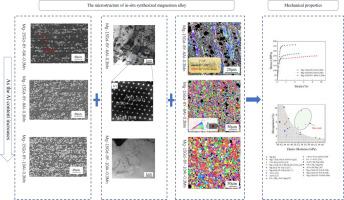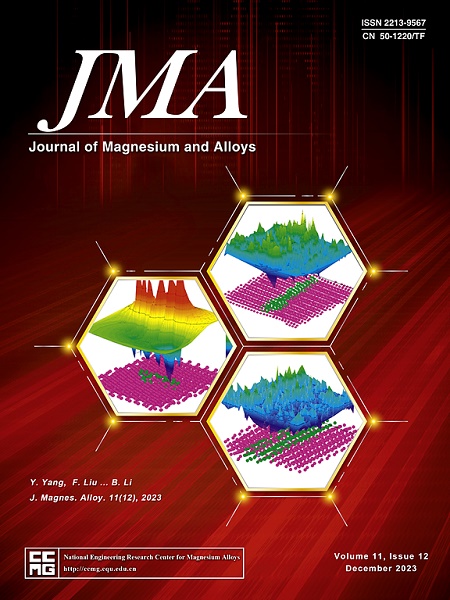高模量镁合金:原位合成Al2RE相对组织和力学性能的控制
IF 15.8
1区 材料科学
Q1 METALLURGY & METALLURGICAL ENGINEERING
引用次数: 0
摘要
镁作为最轻的结构金属,其固有的低弹性模量限制了合金的发展。因此,本研究开发了高性能、高模量Mg-15Gd-8Y-xAl-0.3Mn (wt.%) (x = 6,8,10)合金,并研究了其显微组织和力学性能。结果表明:合金主要由Al2RE相和α-Mg相组成,Al2RE相的数量和尺寸随Al含量的增加而增加;挤压后晶粒细化,Al2RE相细化。合金的模量增加主要是由于高模量Al2RE相的形成。当Al含量为6%、8%和10%时,合金的模量分别为51.8 GPa、53.8 GPa和56.1 GPa。Al2RE和Mg5RE相共同调节合金的组织和力学性能。随着Al含量的增加,Al2RE相的数量增加,消耗了合金中的稀土元素,减少了纳米析出的Mg5RE相。因此,随着Al含量的增加,再结晶速率增加,再结晶晶粒变大。当Al含量为6%时,合金呈现双峰组织,再结晶晶粒最小,屈服强度最高,达到341 MPa。当Al含量为8%时,合金具有精细的、完全再结晶的组织,延伸率较高,达到9.1%。这些发现为设计具有优化屈服强度和延伸率的高模量镁合金提供了有价值的见解。本文章由计算机程序翻译,如有差异,请以英文原文为准。

High-modulus magnesium alloy: Control of microstructure and mechanical properties via in-situ synthesis of the Al2RE phase
Magnesium, being the lightest structural metal, faces limitations in alloy development due to its inherently low elastic modulus. Therefore, this study develops high-performance, high-modulus Mg-15Gd-8Y-xAl-0.3Mn (wt.%) (x = 6, 8, 10) alloys and investigates their microstructure and mechanical properties. The findings indicate that the alloys primarily consist of Al2RE and α-Mg phases, with both the amount and size of Al2RE phase increasing as the Al content rises. After extrusion, both the grains and the Al2RE phase are refined. The increased modulus of the alloys is mainly due to the formation of the high-modulus Al2RE phase. When the Al content is 6 %, 8 %, and 10 %, the modulus of the alloys is 51.8 GPa, 53.8 GPa, and 56.1 GPa, respectively. Additionally, the Al2RE and Mg5RE phases can jointly regulate the microstructure and mechanical properties of the alloys. As the Al content increases, the amount of Al2RE phase increases, consuming the rare earth elements in the alloy and reducing the nano-precipitated Mg5RE phase. Consequently, with the increase in Al content, the recrystallization rate increases, and the recrystallized grains become larger. When the Al content is 6 %, the alloy exhibits a bimodal structure with the smallest recrystallized grains, resulting in the highest yield strength of 341 MPa. When the Al content is 8 %, the alloy has a fine, fully recrystallized structure, leading to a relatively high elongation of 9.1 %. These findings provide valuable insights for designing high-modulus magnesium alloys with optimized yield strength and elongation for structural applications.
求助全文
通过发布文献求助,成功后即可免费获取论文全文。
去求助
来源期刊

Journal of Magnesium and Alloys
Engineering-Mechanics of Materials
CiteScore
20.20
自引率
14.80%
发文量
52
审稿时长
59 days
期刊介绍:
The Journal of Magnesium and Alloys serves as a global platform for both theoretical and experimental studies in magnesium science and engineering. It welcomes submissions investigating various scientific and engineering factors impacting the metallurgy, processing, microstructure, properties, and applications of magnesium and alloys. The journal covers all aspects of magnesium and alloy research, including raw materials, alloy casting, extrusion and deformation, corrosion and surface treatment, joining and machining, simulation and modeling, microstructure evolution and mechanical properties, new alloy development, magnesium-based composites, bio-materials and energy materials, applications, and recycling.
 求助内容:
求助内容: 应助结果提醒方式:
应助结果提醒方式:


